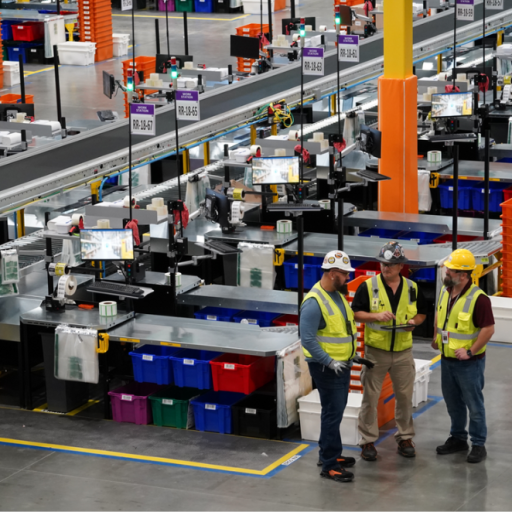Automation Integration – Finding the Appropriate Solutions for Your Customer
By John Saltzman
With the constant advancement of automation technology, material handling companies and their customers face a common challenge: selecting and integrating solutions that align with operational needs. While the marketplace is flooded with automation tools, success hinges not on what is available, but on what is appropriate for a specific facility and its goals, with sight of long-term success.
Below are key strategies MHEDA members can use to help customers navigate automation decisions with confidence.
Evaluate Facility Requirements
and Operational Goals
Automation integration should begin with a comprehensive understanding of the facility, including its layout, throughput requirements and any existing constraints. Every operation has unique demands shaped by factors such as order volume, SKU variability, staffing levels and fulfillment models. Before jumping into automation solutions, it is important to first evaluate how the current processes and resources operate.
Encourage customers to begin with a thorough operational assessment:
- What processes are currently manual and prone to error? Identifying these areas helps pinpoint where automation can provide immediate relief, reducing human error and increasing consistency.
- Where are the workflow inefficiencies or bottlenecks? These may be points where the flow of materials or information slows down, limiting throughput and overall performance. Automation can often smooth these friction points.
- Are there space limitations or labor shortages driving the need for automation? Understanding whether there are physical constraints in the facility or a lack of available skilled workers helps guide decisions about whether to pursue automation that maximizes existing space or increases workforce capacity.
By aligning automation efforts directly with operational pain points, the solution becomes more than just a shiny new technology. It is a practical investment that directly addresses the facility’s most pressing challenges, ensuring that the system deployed is both efficient and scalable for long-term success.
Use an Agnostic Mindset
One of the most valuable practices in automation selection is reviewing a variety of technologies with objectivity. We encourage technology reviews to be neutral, where quality integrators and consultants can explore the full range of solutions available. This would range from robotics and conveyor systems to warehouse management software and control systems, with the evaluation based on its performance fit.
This approach helps:
- Avoid bias toward any single technology or supplier. When companies become too attached to a particular vendor or technology, they may overlook potentially better options. A technology-agnostic mindset ensures that the focus remains on finding the best solution for the specific needs of the business.
- Create tailored solutions for specific business cases. Every operation is unique, with its own set of challenges and goals. By evaluating a broad range of technologies, integrators can develop highly customized solutions that meet the precise requirements of the business, rather than forcing a one-size-fits-all solution.
- Support flexibility and modularity for future adaptation. Technologies and businesses need the capability to evolve. Look for solutions that are scalable and adaptable, ensuring the system can grow and change as the business does.
Customers are best served when recommendations are based on an objective evaluation of all available options, rather than being influenced by limited offerings, brand loyalties or legacy relationships. This unbiased approach leads to more effective and future-proof automation solutions, driving long-term success.
Balance Cost, Scalability
and Efficiency
While it can be tempting to pursue automation based solely on cost savings or the allure of cutting-edge technology, successful integration requires balancing three essential factors:
- Cost: Consider not only the initial investment but also long-term factors like return on investment, ongoing maintenance and lifecycle costs. It is important to account for the total cost of ownership, which includes implementation, training, support and future upgrades. A system that is cheap upfront might result in higher operating costs later if it is not built for longevity or requires frequent maintenance.
- Scalability: The system must be able to grow with the business. As customer demand increases, processes should be able to scale without major overhauls. Choosing flexible systems that can easily integrate with future technologies or expand as needed ensures that businesses are not locked into solutions that become obsolete as their needs evolve.
- Efficiency: Automation should streamline workflows, reduce cycle times and improve consistency. The right solution should eliminate manual tasks, reduce errors and increase throughput. It is about maximizing productivity without overburdening the system. Efficiency also extends to how well the system integrates with other technologies to create a seamless operation.
For many companies, the right approach may be to start small with a phased integration, focusing on high-impact areas where automation can offer immediate benefits and gradually scaling over time. For others, it might be more strategic to invest in a comprehensive solution upfront that can handle increased throughput, anticipating future growth needs.
Balancing these factors helps prevent common pitfalls: over automation, where businesses invest beyond their immediate capacity or under-automation, where systems are chosen that cannot scale or adapt to future needs. By carefully evaluating cost, scalability and efficiency together, companies can ensure that their automation systems are future proof, sustainable and aligned with both short-term needs and long-term goals.
Do Not Forget
the Human Element
Automation does not eliminate the need for people; it changes the roles they play. Part of successful integration includes planning for workforce training, safety and operational handoff. The best systems empower teams by reducing repetitive tasks and enabling higher value work, but this requires a thoughtful change management process.
- Training: Investing in training ensures employees understand how to operate and adapt to new systems, reducing downtime and improving efficiency.
- Change Management: Clear communication is key. Employees need to see how automation supports their work, not replaces it. Early engagement helps ease the transition.
- Safety Considerations: Automation introduces new safety challenges, so updating safety protocols and providing training is essential.
- Empowering Employees: Automation frees workers from repetitive tasks, enabling them to take on more strategic roles and fostering growth and innovation.
Final Thought: Integration
Is the Differentiator
In the automation landscape, the tools may change, but the core need remains the same: a well-integrated system that aligns with each customer’s unique goals. MHEDA members can play a pivotal role by helping clients move beyond product selection and toward solution strategy, turning automation into an asset, not just an investment.
Article Takeaways
- Evaluate Operational Needs. Start automation efforts by assessing facility requirements, identifying inefficiencies and addressing space or labor constraints to ensure solutions meet specific operational goals effectively.
- Adopt a Technology-agnostic Mindset. Evaluate a diverse range of automation technologies objectively to avoid bias, tailor solutions to unique business needs and ensure flexibility for future adaptations.
- Balance Cost, Scalability and Efficiency. Consider total cost of ownership, scalability for future growth and efficiency gains to maximize productivity without overburdening the system.
About the Author
John Saltzman is an automation expert at S&H Systems with deep experience delivering scalable material handling and robotics solutions. His projects include fulfillment operations processing over 1 million units daily with inventories exceeding 20 million SKUs, including 3 million unique SKUs, all within a single facility. John specializes in integrating traditional MHE with large-scale AMR deployments across multi-level environments, including air cargo hubs and high-speed cross-dock operations moving 100,000 packages.




